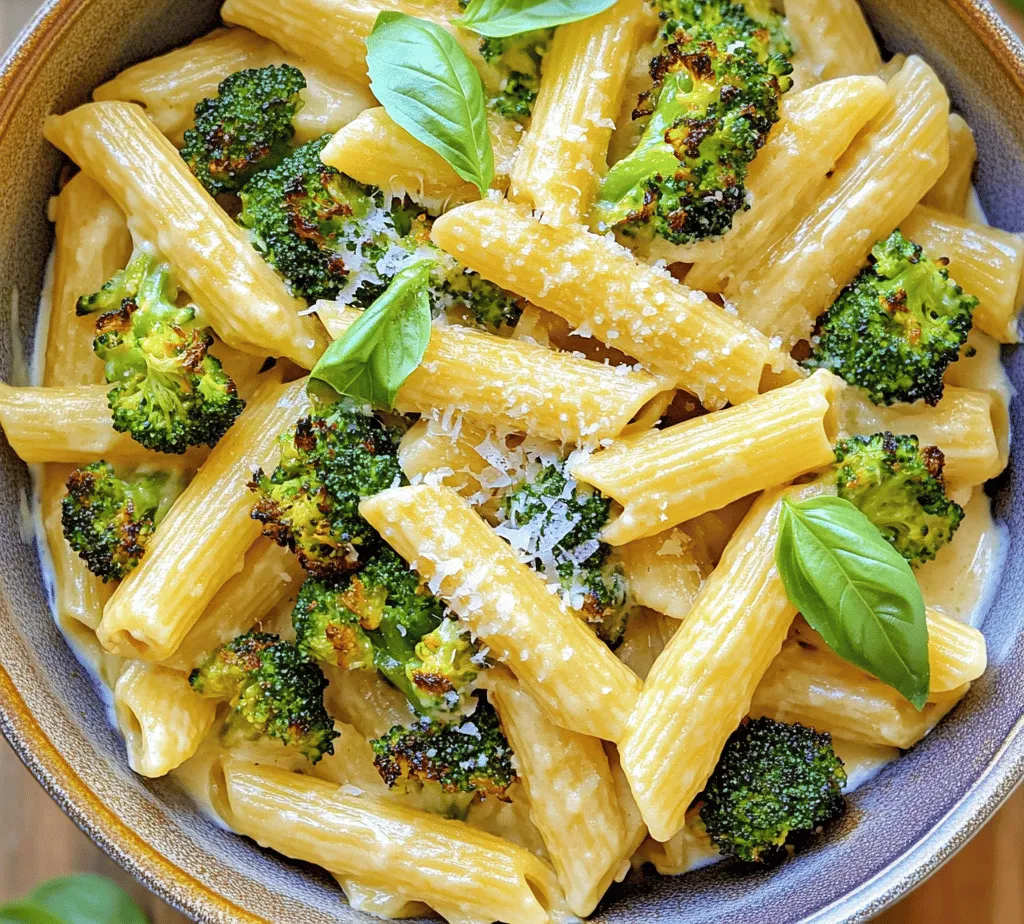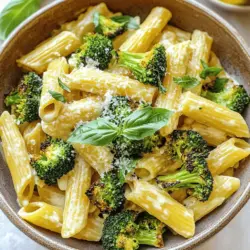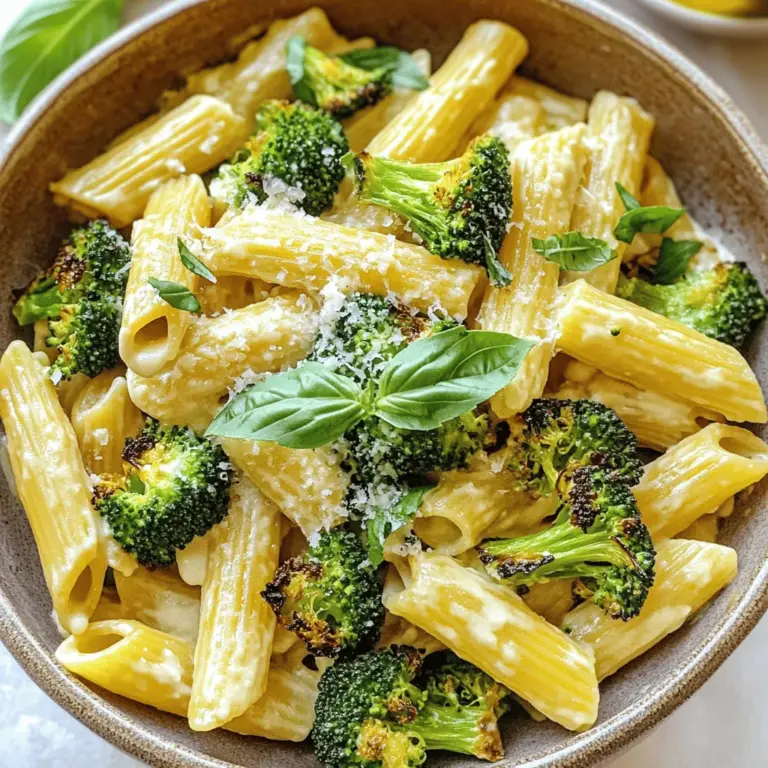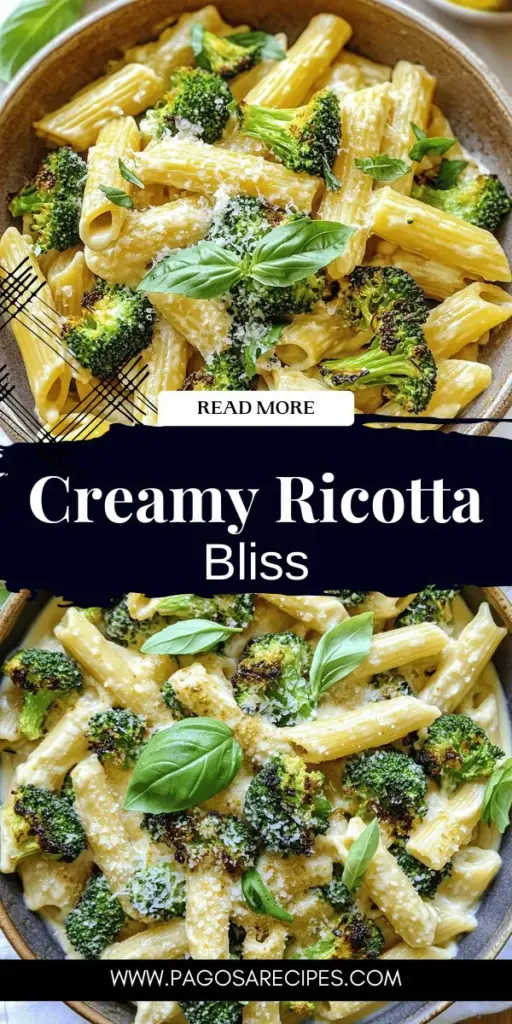Introduction
Creamy pasta dishes hold a special place in the hearts of food lovers around the world. Their rich, indulgent textures and delightful flavors offer a comforting escape from the everyday hustle and bustle. Among the myriad of options, Creamy Ricotta Pasta with Roasted Broccoli stands out as a dish that perfectly balances creamy indulgence with the vibrant, earthy notes of roasted vegetables. This dish not only satisfies the palate but also nourishes the body, making it a favorite among health-conscious home cooks.
The star of this recipe is undoubtedly the combination of creamy ricotta cheese and roasted broccoli. The smooth, velvety texture of ricotta complements the crispy, caramelized edges of the broccoli, creating a delightful contrast that is both satisfying and nutritious. Moreover, this dish is versatile, allowing for various pasta types and additional ingredients, which can be tailored to suit personal preferences.
In addition to being delicious, this creamy pasta dish boasts numerous health benefits. Broccoli is a nutritional powerhouse, packed with vitamins K and C, fiber, and antioxidants. Meanwhile, ricotta cheese provides a creamy texture without excessive fat, and it’s a good source of protein and calcium. This recipe not only pleases the taste buds but also contributes to a balanced diet, making it a wonderful choice for family dinners or casual gatherings with friends.
Understanding the Ingredients
To create the perfect Creamy Ricotta Pasta with Roasted Broccoli, selecting the right ingredients is key. Each component plays a significant role in achieving the dish’s unique flavor and texture. Let’s delve into the essential ingredients that make this recipe a standout.
Pasta Choices
The heart of any pasta dish is, of course, the pasta itself. For this recipe, you can choose from a variety of pasta types, including penne, farfalle, or even spaghetti. Each type has its unique characteristics that can influence the overall experience of the dish:
- Penne: With its tube-like shape, penne is perfect for holding onto the creamy sauce and bits of roasted broccoli. Its slightly chewy texture adds a satisfying bite.
- Farfalle: The bow-tie shape of farfalle adds a playful element to the dish. Its wide surface area allows for maximum sauce coverage, ensuring each bite is packed with flavor.
- Spaghetti: For a more classic approach, spaghetti can be used, allowing the creamy sauce to cling to the strands, creating a deliciously rich experience.
Choosing the right pasta type not only affects the aesthetics of the dish but also how well the sauce adheres, enhancing every bite.
Broccoli
Broccoli is the shining star of this recipe, bringing both flavor and nutrition to the plate. This vibrant green vegetable is known for its numerous health benefits, including:
- High Fiber Content: Promoting digestive health and keeping you feeling full longer.
- Rich in Vitamins: Broccoli is an excellent source of vitamins C and K, both crucial for maintaining a healthy immune system and strong bones.
- Antioxidants: Compounds within broccoli help combat oxidative stress in the body, which can contribute to chronic diseases.
Roasting broccoli enhances its natural flavor and texture, transforming it from a simple vegetable into a crunchy, caramelized delight. This method of cooking also concentrates its nutrients while providing a satisfying contrast to the creamy pasta.
Ricotta Cheese
Ricotta cheese is essential to this creamy pasta dish, contributing a rich, smooth texture that is hard to resist. Its mild flavor pairs beautifully with the roasted broccoli, creating a harmonious blend of tastes. The benefits of ricotta cheese include:
- Protein-Rich: Providing a substantial protein boost that helps to keep you satisfied.
- Calcium Source: Supporting bone health and muscle function.
- Lower in Fat: Compared to other cheeses, ricotta offers a creamy texture without overwhelming calories, making it a healthier option for creamy dishes.
Incorporating ricotta into your pasta not only enhances the creaminess but also adds a touch of sophistication, making it feel indulgent without the guilt.
Parmesan Cheese
To elevate the flavor profile of this dish, grated Parmesan cheese is a must. This hard cheese is known for its sharp, nutty flavor, which complements the creaminess of ricotta perfectly. The role of Parmesan includes:
- Flavor Enhancer: A little goes a long way in amplifying the overall taste of the dish.
- Texture: It adds a delightful salty crunch when sprinkled on top just before serving, contrasting the creamy base.
Using freshly grated Parmesan can significantly enhance the dish’s flavor. It melts beautifully into the pasta, creating a luscious, cohesive sauce that binds the ingredients together.
Herbs and Spices
The subtle blend of herbs and spices is what truly brings this dish to life. Key seasonings include:
- Garlic Powder: Adds depth and a warm, savory note that complements the other flavors.
- Onion Powder: Provides a hint of sweetness and umami, enriching the dish’s overall taste.
- Lemon Zest: Brightens up the flavors with a refreshing citrus note, balancing the creaminess of ricotta.
- Red Pepper Flakes: For those who enjoy a bit of heat, a sprinkle can add a welcome kick, elevating the dish to new heights.
These ingredients work together to create a well-rounded flavor profile that enhances the creamy pasta and roasted broccoli, ensuring that each bite is an explosion of taste.
Preparation Steps for Success
Creating the perfect Creamy Ricotta Pasta with Roasted Broccoli begins with careful preparation. Each step contributes to the final outcome, ensuring that the flavors meld beautifully and the textures remain satisfying.
Prepping the Broccoli
The first step in preparing this dish is selecting the right broccoli. When choosing broccoli, look for vibrant green florets that are tightly packed. Avoid any that show signs of yellowing or wilting. Here’s how to prepare the broccoli for roasting:
1. Wash and Dry: Rinse the broccoli under cool water to remove any dirt or pesticides. Pat it dry with a clean kitchen towel or paper towels to ensure that it roasts properly without steaming.
2. Cutting: Trim the broccoli into uniform-sized florets to ensure even cooking. Aim for pieces that are about 1-2 inches in size. This will allow them to roast evenly and become tender while still retaining some crunch.
3. Stems: Don’t discard the stems! Peel the tough outer layer and slice the tender inner part into rounds. They can be roasted alongside the florets for added texture and flavor.
Roasting Techniques
Roasting is a game-changer when it comes to enhancing the flavor of broccoli. It caramelizes the natural sugars, creating a delicious depth of flavor. Here are some tips to achieve perfectly roasted broccoli:
1. Temperature: Preheat your oven to 425°F (220°C). A high temperature is key to achieving that lovely golden-brown color.
2. Seasoning: Toss the prepared broccoli florets (and stems) in a bowl with olive oil, salt, and pepper. Make sure they are evenly coated, as this will help them roast nicely.
3. Spacing: Spread the broccoli out in a single layer on a baking sheet. Overcrowding the pan can lead to steaming rather than roasting, which will affect the texture.
4. Timing: Roast the broccoli for about 20-25 minutes, flipping halfway through. They should be tender and slightly crispy on the edges when done.
Incorporating these preparation and roasting techniques sets the stage for a dish that is not only delicious but visually appealing as well. The roasted broccoli will add a beautiful contrast to the creamy pasta, making it a feast for the eyes as well as the palate.




